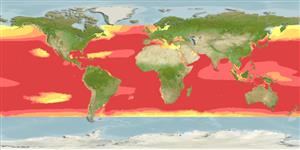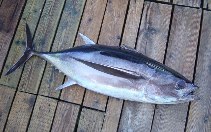Add your observation in Fish Watcher
| Native range | All suitable habitat | Point map | Year 2050 |

|
| This map was computer-generated and has not yet been reviewed. |
| Thunnus alalunga AquaMaps Data sources: GBIF OBIS |
Upload your photos and videos
Pictures | Videos | Stamps, coins, misc. | Google imageThunnus alalunga
Picture by Archambault, C.
Pictures | Videos | Stamps, coins, misc. | Google imageThunnus alalunga
Picture by Archambault, C.
India country information
Common names:
Albacore
Occurrence: native
Salinity: marine
Abundance: | Ref:
Importance: | Ref:
Aquaculture: | Ref:
Regulations: | Ref:
Uses: no uses
Comments:
National Checklist:
Country Information: https://www.cia.gov/library/publications/resources/the-world-factbook/geos/in.html
National Fisheries Authority:
Occurrences: Occurrences Point map
Main Ref: Kapoor, D., R. Dayal and A.G. Ponniah, 2002
National Database:
Occurrence: native
Salinity: marine
Abundance: | Ref:
Importance: | Ref:
Aquaculture: | Ref:
Regulations: | Ref:
Uses: no uses
Comments:
National Checklist:
Country Information: https://www.cia.gov/library/publications/resources/the-world-factbook/geos/in.html
National Fisheries Authority:
Occurrences: Occurrences Point map
Main Ref: Kapoor, D., R. Dayal and A.G. Ponniah, 2002
National Database:
Common names from other countries
Classification / Names প্রচলিত নাম সমূহ | প্রতিনাম সমূহ | Catalog of Fishes(গণ , প্রজাতি ) | ITIS | CoL | WoRMS | Cloffa
> Scombriformes (Mackerels) > Scombridae (Mackerels, tunas, bonitos) > Scombrinae
Etymology: Thunnus: Greek, thynnos = tunna (Ref. 45335).
More on author: Bonnaterre.
Etymology: Thunnus: Greek, thynnos = tunna (Ref. 45335).
More on author: Bonnaterre.
Environment: milieu / climate zone / depth range / distribution range বাস্তুসংস্থান
সামুদ্রিক; মহাসাগরে বিচরনক্ষম (Ref. 51243); গভীরতার পরিসীমা 0 - 600 m (Ref. 168). Subtropical; 10°C - 25°C (Ref. 168); 60°N - 50°S, 180°W - 180°E
বিতরণ দেশ সমূহ | এফ এ ও এলাকাসমূহ | বাস্তুতন্ত্র | দৃষ্টিগোচর | Point map | প্রচলন | Faunafri
Cosmopolitan in tropical and temperate waters of all oceans including the Mediterranean Sea but not at the surface between 10°N and 10°S. Western Pacific: range extend in a broad band between 40°N and 40°S (Ref. 9684). Often confused with juvenile Thunnus obesus which also have very long pectorals but with rounded tips. Highly migratory species.
Length at first maturity / আকৃতি / ওজন / Age
Maturity: Lm 85.2, range 83 - ? cm
Max length : 140 cm FL পুরুষ/ লিঙ্গ অনিধর্ারিত ; (Ref. 3669); common length : 100.0 cm FL পুরুষ/ লিঙ্গ অনিধর্ারিত ; (Ref. 9684); সবের্াচ্চ প্রকাশিত ওজন : 60.3 kg (Ref. 40637); সর্বোচ্চ উলি্ল্লখিত বয়স : 9 বৎসর (Ref. 72462)
Max length : 140 cm FL পুরুষ/ লিঙ্গ অনিধর্ারিত ; (Ref. 3669); common length : 100.0 cm FL পুরুষ/ লিঙ্গ অনিধর্ারিত ; (Ref. 9684); সবের্াচ্চ প্রকাশিত ওজন : 60.3 kg (Ref. 40637); সর্বোচ্চ উলি্ল্লখিত বয়স : 9 বৎসর (Ref. 72462)
Short description সনাক্তকারী নির্দেশক | বহিঃ অঙ্গ সংস্থান | মরফোমেট্রিক্স
পৃষ্ঠীয় কাঁটা (মোট ) : 11 - 14; পৃষ্ঠীয় নরম পাখনা দন্ড (মোট ) : 12 - 16; পায়ূ কাঁটা : 0; পায়ূর নরম পাখনা্তুন্ড: 11 - 16. Anterior spines much higher than posterior spines giving the fin a strongly concave outline. Interpelvic process small and bifid. Body with very small scales. Pectoral fins remarkably long, about 30% of fork length or longer in 50 cm or longer fish. Ventral surface of liver striated and the central lobe is largest.
An epipelagic and mesopelagic, oceanic species, abundant in surface waters of 15.6° to 19.4°C; deeper swimming, large albacore are found in waters of 13.5° to 25.2°C; temperatures as low as 9.5°C may be tolerated for short periods (Ref. 168). Known to concentrate along thermal discontinuities (Ref. 168). Form mixed schools with skipjack tuna (Katsuwonus pelamis), yellowfin tuna (Thunnus albacares) and bluefin tuna (T. maccoyii), schools may be associated with floating objects, including sargassum weeds (Ref. 168). Feed on fishes, crustaceans and squids. Eggs and larvae are pelagic (Ref. 6769). Sexual maturity reached at 90 cm (Ref. 36731). Highly appreciated and marketed fresh, smoked, deep frozen or canned. Eaten steamed, broiled, fried and microwaved (Ref. 9987). Also Ref. 1762, 1798, 1804.
Angling: Largely caught offshore, where the waters are mild and blue. Albacore favor those areas where cooler water interfaces with warmer water. They are caught with live of dead baitfish such as mullet, sauries, squid, herring, anchovies, sardines, and other small fish. Albacore strike hard and make powerful runs (Ref. 84357).
Life cycle and mating behavior পরিপক্কতা | প্রজনন | ডিম ছাড়া | ডিমসমূহ | ডিম্বধারন ক্ষমতা | শুককীট
The sex ratio in catches is about 1:1 for immature individuals, but males predominate among mature fishes, which is possibly due to both differential mortality of sexes and differential growth rate after maturity.
Main reference
Upload your references | সূত্র সংখ্যা | সমম্বয়কারী : Collette, Bruce B. | সহযোগী
Collette, B.B. and C.E. Nauen, 1983. FAO Species Catalogue. Vol. 2. Scombrids of the world. An annotated and illustrated catalogue of tunas, mackerels, bonitos and related species known to date. Rome: FAO. FAO Fish. Synop. 125(2):137 p. (Ref. 168)
IUCN Red List Status (Ref. 130435: Version 2024-2)
Least Concern (LC) ; Date assessed: 15 January 2021
Threat to humans
Harmless
Human uses
মৎস্য: অত্যন্ত বাণিজ্যিক ; শিকারযোগ্য মাছ: হঁ্যা
FAO(মৎস্য: উৎপাদন , species profile; publication : search) | FIRMS (Stock assessments) | FishSource | আমাদের চতুর্পাশ্বের সাগর
আরো তথ্য
Population dynamics
Growth parameters
Max. ages / sizes
Length-weight rel.
Length-length rel.
Length-frequencies
Mass conversion
নির্বাচন
প্রাচুর্য
Growth parameters
Max. ages / sizes
Length-weight rel.
Length-length rel.
Length-frequencies
Mass conversion
নির্বাচন
প্রাচুর্য
Physiology
Body composition
Nutrients
অম্লজান ব্যবহার
-এর সাতাঁরের ধরণ
সাতাঁরের গতি
Visual pigments
Fish sound
Diseases & Parasites
Toxicity (LC50s)
Body composition
Nutrients
অম্লজান ব্যবহার
-এর সাতাঁরের ধরণ
সাতাঁরের গতি
Visual pigments
Fish sound
Diseases & Parasites
Toxicity (LC50s)
হাতিয়ার
E-book | মাঠ পর্যায়ের নির্দেশক | সনাক্তকারী নির্দেশক | দৈঘ্যর্ের ঘটন সংখ্যা জাদুকর | জীবন ইতিহাস হাতিয়ার | মানচিত্র নির্দেশ করুন | Classification Tree
| Catch-MSY |
Special reports
Download XML
ইন্টারনেট সুত্র
Aquatic Commons | BHL | Cloffa | BOLDSystems | Websites from users | Check FishWatcher | CISTI | Catalog of Fishes(গণ , প্রজাতি ) | DiscoverLife | ECOTOX | Faunafri | Fishtrace | GenBank(genome, nucleotide) | GloBI | GOBASE | | Google Books | Google Scholar | Google | IGFA World Record | MitoFish | জাতীয় উপাত্ত সমূহ | Otolith Atlas of Taiwan Fishes | PubMed | Reef Life Survey | RFE Identification | Scirus | SeaLifeBase | জীবন বৃক্ষ | Wikipedia(Go, অনুসন্ধান ) | World Records Freshwater Fishing | জুলজিকাল রেকর্ড
Estimates based on models
Preferred temperature (Ref. 115969): 8.8 - 21.2, mean 15.1 (based on 784 cells).
Phylogenetic diversity index (Ref. 82804): PD50 = 0.5039 [Uniqueness, from 0.5 = low to 2.0 = high].
Bayesian length-weight: a=0.01698 (0.01397 - 0.02064), b=3.01 (2.98 - 3.04), in cm Total Length, based on LWR estimates for this species (Ref. 93245).
ট্রফিক পর্যায়ে (Ref. 69278): 4.3 ±0.2 se; based on diet studies.
স্থিতিস্থাপক (Ref. 120179): মাধ্যম , সর্বনিম্ন প্রজন দ্বিগুনের সময় ১.৪-৪.৪ বৎসর (K=0.13-0.18; tm=4-6; tmax=10; Fec=2 million).
Prior r = 0.43, 95% CL = 0.28 - 0.64, Based on 15 full stock assessments.
Fishing Vulnerability (Ref. 59153): High to very high vulnerability (71 of 100).
Climate Vulnerability (Ref. 125649): Moderate vulnerability (42 of 100).




